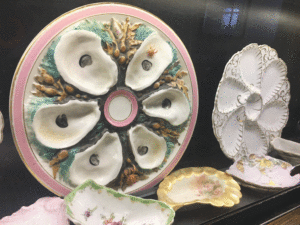
There are dozens of oyster plates, part of a personal collection of the Schultz family, on display at Fisherman’s Inn in Grasonville, Md. (Photo by Kevin George)
The oyster plate is collected by many antique aficionados who enjoy the beauty, elegance and nautical lure of such an object.
There is a rich Victorian past with the oyster plate, as well as hostess rules and impressing affluent guests with these little wonders of artwork in porcelain.
The oyster plate was first conceptualized in the time of the Victorians.
Oysters, at the time, were thought of as a shellfish delicacy, and the plates represented your ability to project your knowledge and wealth of the world around you.
The plates were beautiful, sometimes intricate, delicate, and showcased the food delicacy with flare.
Oyster plate production went into full swing during Victorian times with hand painted motifs, floral patterns, unique patterns and makers from around the world.
Plate production slowed down after World War I when the lifestyle of the Victorians and serving such a thing as a “delicacy” became a thing of forgotten times.
In the United States, factories that made porcelain responded to the obsession with this special delicacy by designing plates for the elite class to serve their guests.
Silver-plated forks also were designed to accompany the plates, and lavish dinner parties among the East Coast elite in the 1870s and 1880s served dishes made by famous companies such as Union Porcelain Works, Limoges of France and other fine European and American factories.
Increased affluence from the gilded age of the Victorians, with mass production of the industrial revolution, which allowed for easier production on a larger scale, fueled the passion and obsession with the oyster plate.
The plates were normally made to serve the food without the shells.
Shells tended to scratch and damage the delicate designs and the plates themselves.
When collecting plates in the market, collectors look for plates that do not have damage of any kind.
The more color and stylized design on the plate, such as hand painted sea scenes or intricate floral motifs command more money in the antiques market, and a buyer will pay more for a beautifully intricate plate.
Some of the oldest and least damaged plates command amounts anywhere from $175 to $300 in today’s market, whereas on the lower end, a seller could only realize $50 for a newer or damaged plate.
Plates come in three different styles. There is the turkey, which has five wells for the oysters and generally resembles a shape of a turkey when put together.
There is the geometric shape, which is six wells, uniform in construction, with a center hole for sauce, and the kidney shaped, which is shaped like a kidney and holds oysters and their respective sauces.
Delving into the past and how we consumed food and what was considered a delicacy explains some of the culinary antiques in today’s world.
Oyster plates represent the audacity of the Victorians, the might of the porcelain factories, the imagination of the artist’s hand, and the passion of a collector today.
Oyster plates show us all that is beautiful yet utilitarian in today’s antiques market, while shining a light on our Victorian-influenced past.
(Editor’s note: DeeDee Wood is the store manager at Tharpe Antiques, in Easton, part of the Talbot Historical Society.)



